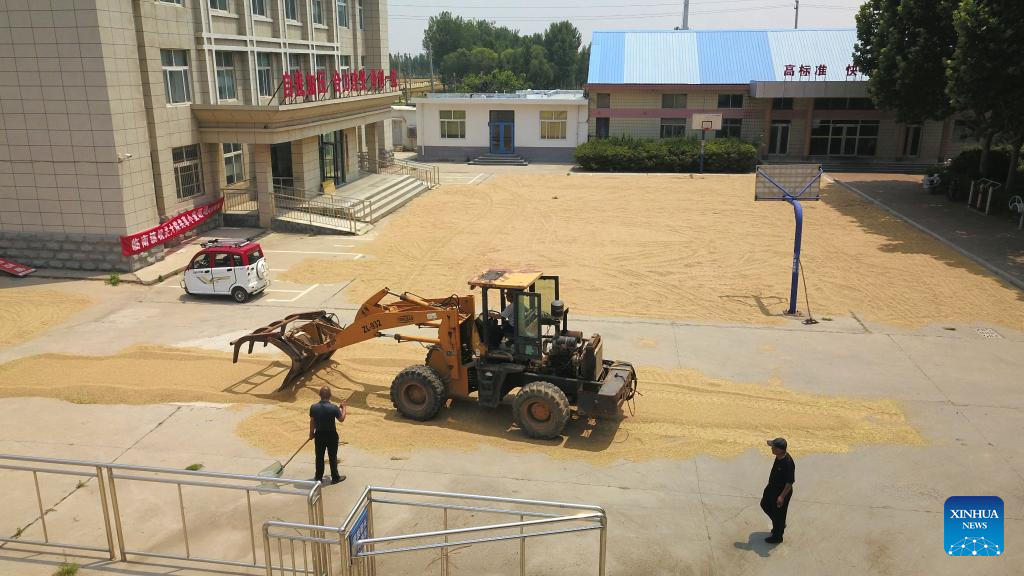China guards summer harvest, life order against scorching heatwaves

This aerial photo shows farmers drying grain at the government compound of Linyi Town in Linyi County, east China's Shandong Province, June 13, 2023. As the latest round of heatwaves coincides with the summer harvest season, many cities in Shandong have opened government compounds and village entertainment venues and squares for farmers to dry their grain. (Xinhua/Xu Suhui)
BEIJING, June 16 (Xinhua) -- On Thursday, China's meteorological authorities released an alert for heat stroke, 13 days earlier than the average date of previous years.
This week, more than one-fifth of the Chinese territory, covering Beijing, Tianjin, Hebei and Shandong, have been gripped by the sweltering weather, with temperatures surpassing 35 degrees Celsius on some days. Notably, four national meteorological stations in Beijing and Hebei saw record high temperatures for June on Thursday.
According to the latest forecast, seven Chinese provincial-level regions are expected to see some areas endure a scorching heat of over 40 degrees Celsius on Friday.
This round of heatwaves started around Wednesday. As of 5 p.m. Thursday, eight regional capital cities had recorded a new high for daytime temperatures this year. Shijiazhuang, capital of north China's Hebei Province, recorded a daytime temperature of 40.4 degrees Celsius, exceeding 40 degrees Celsius for the first time this year.
Agriculture, tourism, industry and education authorities across the country have mustered their efforts to safeguard local production and life in response to the extreme heat.
STABLE PRODUCTION, LIFE
Jinan, capital of east China's Shandong Province, has ordered sanitation workers to suspend outdoor work between 11 a.m. and 4 p.m., when the daytime temperature exceeds 35 degrees Celsius, and to stop all outdoor operations for the whole day, when the temperature climbs to over 38 degrees Celsius.
Construction sites in the city took similar measures. No workers will be allowed to work when the maximum temperature during the day reaches 40 degrees Celsius or above.
As the latest round of heatwaves coincides with the summer harvest season, many cities in Shandong have opened government compounds and village entertainment venues and squares for farmers to dry their grain. Meanwhile, the cities are also opening office spaces to citizens as an escape from the blistering heat, with bottled water and medicine on offer.
Hu Xiao, chief weather analyst from Weather China, a weather service website founded by the China Meteorological Administration, warned of possible damage to spring-sown crops in the affected regions.
"In this spring, some western part of northeast China, the country's major grain producing area, saw slightly less precipitation. And the latest round of heatwaves will accelerate the moisture loss of soil, and thus we should pay heed to the spring-sown crops," Hu explained.
Utility departments in Beijing, Tianjin and other major Chinese cities have strengthened real-time monitoring and patrols to ensure electricity and water supply during the peak season.
On Thursday, Tianjin recorded a maximum power grid load of 14.54 million kilowatts, an increase of 23 percent year on year, due to the high temperatures. Over 50 workers are patrolling the city's underground tunnels every day to ensure the safety of electricity cables.
"With the increase in economic activities in the second quarter and the impact of the recent temperature rise, the load of Beijing's power grid has gradually grown by about 30 percent compared with the same period last year," said Zhao Rui, an engineer with the Beijing branch of the State Grid Corporation of China.
The Beijing branch has deployed 261 troubleshooting teams and 109 power-generating trucks that are on standby around the clock for emergencies, Zhao added.
"At around 10 a.m., the ground temperature in the transformer substation was almost over 40 degrees Celsius, and we could still feel the heat of the cement floor through our thick insulant shoes," said Feng Zhengjun, a worker with the electricity company in Baoding City, Hebei Province.
To ward off sunburn, the staff in the transformer substation all wore special protective facial masks and were offered cool water, mung bean soup and portable medical kits.
BLESSING IN DISGUISE
Starting from Saturday, most of the plain areas in northwest China's Xinjiang Uygur Autonomous Region are expected to undergo four days of scorching weather above 35 degrees Celsius. Its city of Turpan, often dubbed as China's "land of fire," is likely to experience extreme high temperatures up to 40 degrees around June 19.
"The heatwave, however, helps with reaping and drying winter wheat in southern Xinjiang, and with growing thermophilic crops such as cotton and corn," said Yang Xia, chief forecaster of the regional meteorological observatory.
Yang also reminded that as Xinjiang embraces its tourist season around summer, the local scenic spots should pay close attention to the early warnings and take preventive measures in case of continuous high temperatures or heavy rains.
Entering June, Turpan City has seen its daily maximum temperature exceed 45 degrees Celsius. On June 13, the city's weather observatory said the best period for tourists to experience the local signature "sand bath therapy" has come.
Avoiding unpleasant high temperatures between 2 p.m. and 5 p.m., curious tourists can have a try of the sand bath in the city under the professional guidance of local medics.
The city's weather bureau is planning to provide real-time meteorological monitoring for tourists that have come for the "sand bath therapy."
Temperatures are still on the rise in most parts of China. Thankfully, odds favor that the hot weather will start to weaken significantly from Saturday and basically end on Sunday, according to the National Meteorological Center.

Farmers transport newly harvested grain to the government compound for drying, in Linnan Town in Linyi County, east China's Shandong Province, June 13, 2023. As the latest round of heatwaves coincides with the summer harvest season, many cities in Shandong have opened government compounds and village entertainment venues and squares for farmers to dry their grain. (Xinhua/Xu Suhui)

This aerial photo shows a farmer drying grain at the government compound of Linyi Town in Linyi County, east China's Shandong Province, June 13, 2023. As the latest round of heatwaves coincides with the summer harvest season, many cities in Shandong have opened government compounds and village entertainment venues and squares for farmers to dry their grain. (Xinhua/Xu Suhui)

Farmers unload newly harvested grain to the government compound for drying, in Linnan Town in Linyi County, east China's Shandong Province, June 13, 2023. As the latest round of heatwaves coincides with the summer harvest season, many cities in Shandong have opened government compounds and village entertainment venues and squares for farmers to dry their grain. (Xinhua/Xu Suhui)

This aerial photo shows farmers drying grain at the government compound of Linpan subdistrict in Linyi County, east China's Shandong Province, June 13, 2023. As the latest round of heatwaves coincides with the summer harvest season, many cities in Shandong have opened government compounds and village entertainment venues and squares for farmers to dry their grain. (Xinhua/Xu Suhui)

This aerial photo shows farmers drying grain at the government compound of Linnan Town in Linyi County, east China's Shandong Province, June 13, 2023. As the latest round of heatwaves coincides with the summer harvest season, many cities in Shandong have opened government compounds and village entertainment venues and squares for farmers to dry their grain. (Xinhua/Xu Suhui)

A staff member (L) of the State Grid Tianjin Electric Power Company wears a positive pressure respirator before he patrols underground tunnels in Tianjin, north China, June 16, 2023. (Xinhua)
Photos
Related Stories
- Alfalfa crops harvest in Gansu
- China takes multi-pronged measures to ensure summer harvest
- Wheat harvest nearing completion in China's Henan
- Wheat harvested in SW China's Guizhou
- Chinese provinces go all out to speed up wheat harvest
- Harvesters reap wheat in Jingjiang, E China's Jiangsu Province
- Winter wheat harvest begins in Wangjiang, E China's Anhui
- Red pepper harvest adds flavor to life in S China's Guangxi
- Large wax gourds yield bumper harvest in S China's Hainan
- Village in S China’s Guangdong sees bumper winter potato harvest
Copyright © 2023 People's Daily Online. All Rights Reserved.









